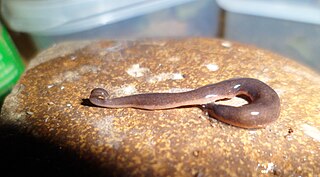
Imbira is a genus of land planarians found in South America.

Obama ladislavii is a species of Brazilian land planarian in the subfamily Geoplaninae. It is one of the most common land planarians in human-disturbed environments in southern Brazil and is easily identifiable by the green color of its dorsum.

Luteostriata abundans is a species of Brazilian land planarian in the subfamily Geoplaninae. It is a common species in human-disturbed areas in Brazil's southernmost state, Rio Grande do Sul.

Obama anthropophila is a species of Brazilian land planarian in the subfamily Geoplaninae. It is a very common land planarian in human-disturbed environments in southern and southeastern Brazil.

Obama ficki is a large species of Brazilian land planarian in the subfamily Geoplaninae.

Obama josefi is a species of Brazilian land planarian in the subfamily Geoplaninae.

Cratera ochra is a species of land planarian in the subfamily Geoplaninae. It is found in Brazil
Cratera aureomaculata is a species of land planarian from Brazil.
Cratera steffeni is a species of land planarian belonging to the subfamily Geoplaninae. It is found in Rio Grande do Sul, Brazil.

Choeradoplana benyai is a species of land planarian belonging to the subfamily Geoplaninae. It is found in areas of Atlantic Forest within Rio Grande do Sul, Brazil, such as São Francisco de Paula.

Choeradoplana minima is a species of land planarian belonging to the subfamily Geoplaninae. It is found in areas of Atlantic Forest within Rio Grande do Sul, Brazil, such as São Francisco de Paula.
Obama decidualis is a species of land planarian belonging to the subfamily Geoplaninae. It is found within Brazil.

Choeradoplana longivesicula is a species of land planarian belonging to the subfamily Geoplaninae. It is known from specimens found in General Carneiro, Brazil.

Choeradoplana cyanoatria is a species of land planarian belonging to the subfamily Geoplaninae. It is known from specimens found in General Carneiro, Brazil.
Cratera obsidiana is a species of land planarian belonging to the subfamily Geoplaninae. It is known from specimens found in the Turvo State Park in Brazil.
Luteostriata subtilis is a species of land planarian belonging to the subfamily Geoplaninae. It is known from specimens found in Brazil.

Matuxia tymbyra is a species of land planarian belonging to the subfamily Geoplaninae. It is found within Brazil.
Pasipha variistriata is a species of land planarian belonging to the subfamily Geoplaninae. It is found within Brazil.
Pasipha tutameia is a species of land planarian belonging to the subfamily Geoplaninae. It is found within Brazil.

Winsoria is a genus of land planarian belonging to the family Geoplaninae. It is monotypic, containing the sole species Winsoria bipatria. It is found in Argentina and Brazil.












